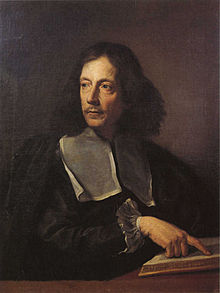
Back جيان بيترو بيلورى ARZ Giovanni Pietro Bellori Catalan Giovanni Pietro Bellori German Τζοβάννι Πιέτρο Μπελλόρι Greek Giovanni Pietro Bellori Spanish Giovanni Pietro Bellori French Giovanni Pietro Bellori Italian ジョヴァンニ・ピエトロ・ベッローリ Japanese Ioannes Petrus Bellorius Latin Giovanni Pietro Bellori Lithuanian
Giovanni Pietro Bellori | |
|---|---|
 Gian Pietro Bellori, portrait by Carlo Maratta | |
| Born | January 15, 1613 |
| Died | February 19, 1696 (aged 83) |
| Resting place | Church of S. Isidoro |
| Occupation(s) | Biographer, painter, librarian, art historian, historian, archaeologist |
| Known for | Lives of the Artists |
| Parent(s) | Giacomo Bellori and Artemetia Bellori (née Giannotti) |
| Academic background | |
| Influences | |
| Academic work | |
| Discipline | Classical archaeology, art history, aesthetics |
| Influenced | |
Giovanni Pietro Bellori (15 January 1613 – 19 February 1696),[7] also known as Giovan Pietro Bellori or Gian Pietro Bellori, was an Italian art theorist, painter and antiquarian, who is best known for his work Lives of the Artists, considered the seventeenth-century equivalent to Vasari's Vite. His Vite de' Pittori, Scultori et Architetti Moderni,[8] published in 1672, was influential in consolidating and promoting the theoretical case for classical idealism in art.[9] As an art historical biographer, he favoured classicising artists rather than Baroque artists to the extent of omitting some of the key artistic figures of 17th-century art altogether.
- ^ a b c d Donahue 1965.
- ^ George Alexander Kennedy; H. B. Nisbet; Claude Rawson; Raman Selden, eds. (1989). The Cambridge History of Literary Criticism. Vol. 4. Cambridge University Press. p. 110. ISBN 9780521317207.
- ^ Malvasia, Carlo Cesare (2000). Malvasia's Life of the Carracci: Commentary and Translation. Penn State Press. p. 37. ISBN 0-271-01899-2.
- ^ Panofsky, Erwin (1968). Idea: a Concept in Art Theory. University of South Carolina Press. p. 242.
Bellori is the "predecessor of Winckelmann" not only as an antiquarian but also as an art theorist. Winckelmann's theory of the "ideally beautiful" as he expounds it in Geschichte der Kunst des Altertums, IV.2.33 ff., thoroughly agrees—except for the somewhat stronger Neoplatonic impact, which is to be explained perhaps more as an influence of Raphael Mengs than as an influence of Shaftesbury—with the content of Bellori's Idea (to which Winckelmann also owes his acquaintance with the letters of Raphael and Guido Reni); he frankly recognizes this indebtedness in Anmerkungen zur Geschichte der Kunst des Altertums (1767), p. 36.
- ^ Von Schlosser, Julius Ritter (1924). Die Kunstliteratur: Ein Handbuch zur Quellenkunde der neueren Kunstgeschichte. Vienna: Kunstverlag Anton Schroll & Co. p. 423.
- ^ Baeumler, Alfred (1999) [1934]. Estetica. Padova: Edizioni di Ar. p. 124.
- ^ Pace 1996.
- ^ Bellori 1672.
- ^ Wittkower 1999, vol. 2, p. 87.
© MMXXIII Rich X Search. We shall prevail. All rights reserved. Rich X Search